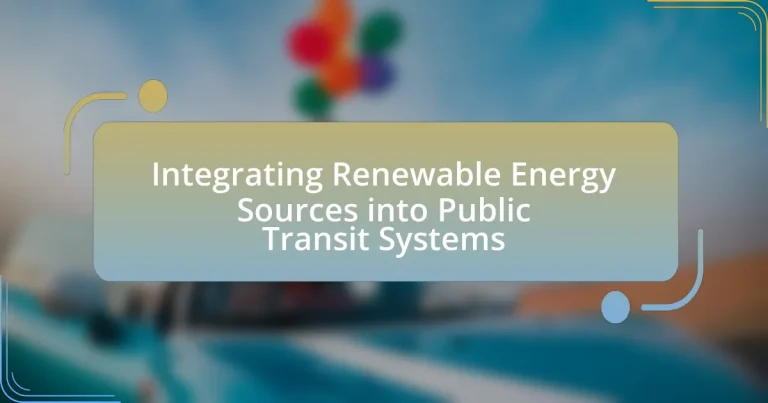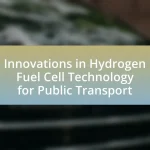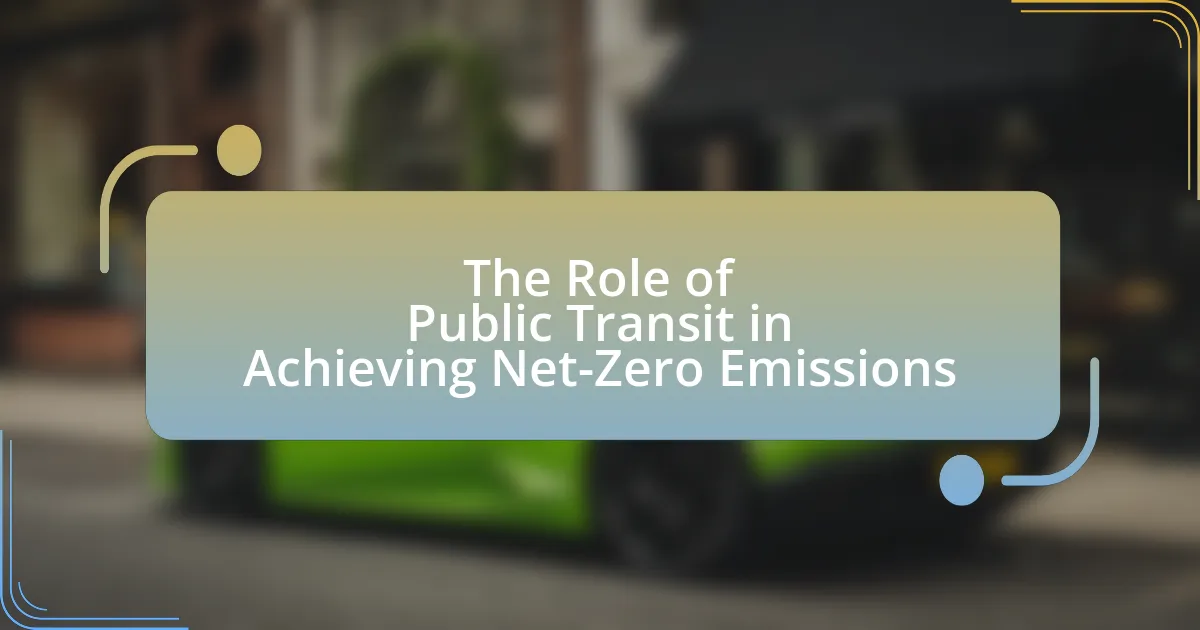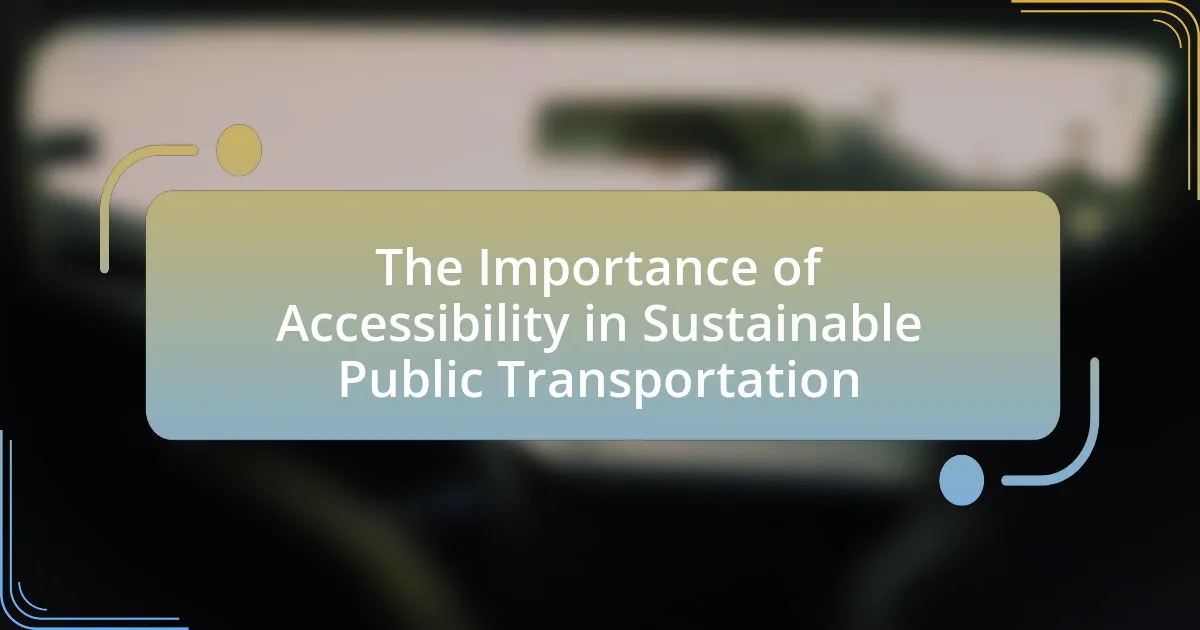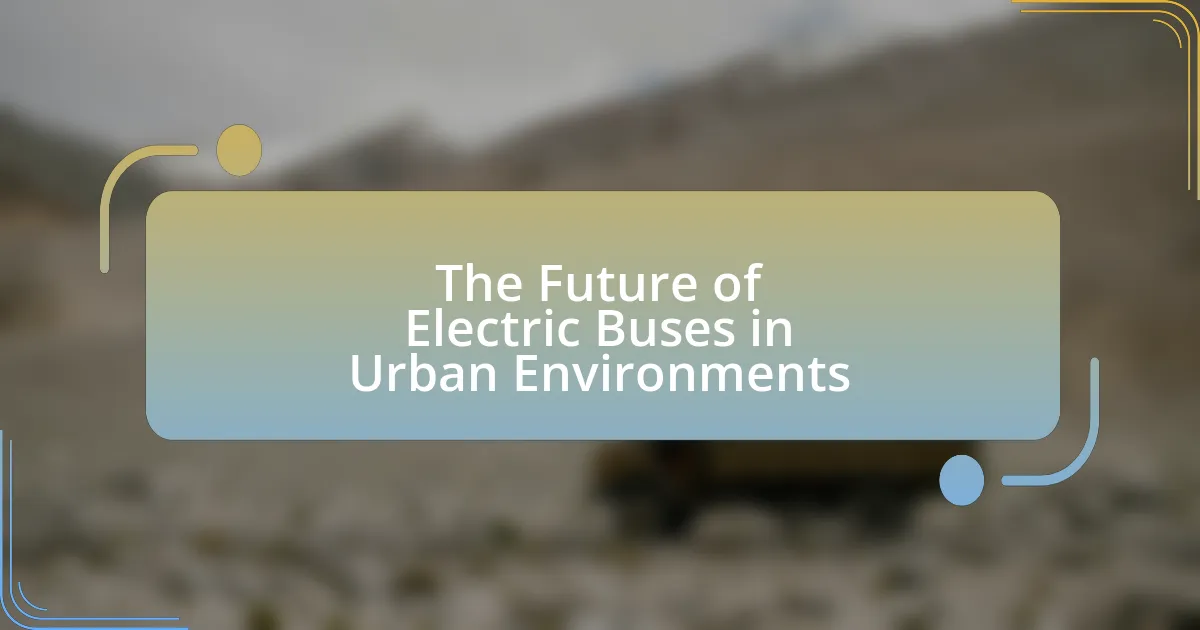Integrating renewable energy sources into public transit systems involves the adoption of sustainable technologies such as solar, wind, and bioenergy to power transit vehicles and infrastructure. This transition not only reduces greenhouse gas emissions by up to 70% but also lowers operational costs and enhances energy independence. Key renewable energy sources utilized include solar panels, electric buses, and biofuels, which collectively improve the efficiency and sustainability of public transit. Challenges such as high initial costs and infrastructure limitations must be addressed, while strategic planning and collaboration with energy providers can facilitate successful implementation. The article explores these aspects, highlighting best practices, technological advancements, and future trends in renewable energy integration within public transit systems.
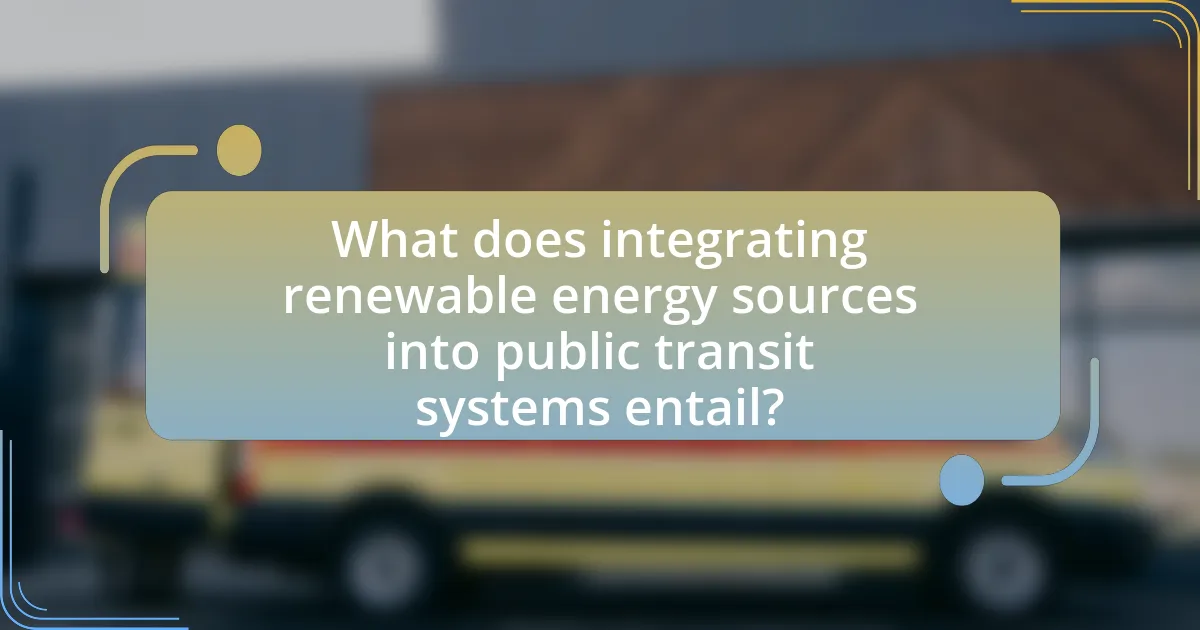
What does integrating renewable energy sources into public transit systems entail?
Integrating renewable energy sources into public transit systems entails the incorporation of sustainable energy technologies, such as solar, wind, and bioenergy, to power transit vehicles and infrastructure. This integration involves retrofitting existing transit systems with renewable energy technologies, such as installing solar panels on bus depots or utilizing electric buses charged by renewable sources. For instance, a study by the American Public Transportation Association indicates that transitioning to electric buses can reduce greenhouse gas emissions by up to 70% compared to diesel buses. Additionally, implementing smart grid technologies allows for efficient energy management, optimizing the use of renewable energy in real-time.
How do renewable energy sources contribute to public transit systems?
Renewable energy sources significantly enhance public transit systems by providing sustainable power for operations, reducing greenhouse gas emissions, and lowering operational costs. For instance, electric buses powered by solar or wind energy can operate with minimal environmental impact, contributing to cleaner air in urban areas. According to the American Public Transportation Association, transitioning to renewable energy can reduce transit-related emissions by up to 70%. Additionally, integrating solar panels into transit facilities can generate on-site energy, further decreasing reliance on fossil fuels and promoting energy independence. This shift not only supports environmental goals but also aligns with economic benefits, as renewable energy often leads to lower long-term energy costs for transit agencies.
What types of renewable energy sources are commonly used in public transit?
Commonly used renewable energy sources in public transit include solar energy, wind energy, and biofuels. Solar energy is harnessed through photovoltaic panels installed on transit vehicles and infrastructure, providing a clean power source for operations. Wind energy is utilized in some transit systems through wind turbines that generate electricity for electric buses and trains. Biofuels, derived from organic materials, are increasingly adopted as an alternative to traditional fossil fuels in buses and other vehicles, contributing to reduced greenhouse gas emissions. These renewable sources are integral to enhancing sustainability in public transit systems.
How do these energy sources impact the efficiency of public transit systems?
Renewable energy sources significantly enhance the efficiency of public transit systems by reducing operational costs and increasing reliability. For instance, electric buses powered by solar or wind energy can lower fuel expenses and maintenance costs compared to traditional diesel buses. A study by the American Public Transportation Association found that electric buses can reduce greenhouse gas emissions by up to 70% compared to their fossil fuel counterparts, which not only improves environmental sustainability but also attracts more riders due to cleaner air and quieter operations. Additionally, integrating renewable energy into transit systems can lead to energy independence and resilience against fuel price volatility, further optimizing overall system efficiency.
Why is the integration of renewable energy important for public transit?
The integration of renewable energy is important for public transit because it reduces greenhouse gas emissions and enhances sustainability. Public transit systems that utilize renewable energy sources, such as solar or wind power, can significantly lower their carbon footprint, contributing to climate change mitigation. For instance, a study by the American Public Transportation Association found that public transit saves 45 million metric tons of carbon dioxide annually, and integrating renewable energy can further amplify these benefits by providing cleaner energy alternatives. This transition not only supports environmental goals but also promotes energy independence and can lead to cost savings in the long run through reduced reliance on fossil fuels.
What environmental benefits arise from using renewable energy in transit?
Using renewable energy in transit significantly reduces greenhouse gas emissions. For instance, electric buses powered by solar or wind energy can decrease carbon dioxide emissions by up to 70% compared to diesel buses. Additionally, renewable energy sources contribute to improved air quality by minimizing pollutants such as nitrogen oxides and particulate matter, which are prevalent in fossil fuel combustion. This transition not only mitigates climate change impacts but also enhances public health by reducing respiratory issues associated with air pollution.
How does renewable energy integration affect operational costs?
Renewable energy integration generally reduces operational costs for public transit systems. By utilizing sources like solar and wind energy, transit agencies can decrease their reliance on fossil fuels, which are subject to price volatility. For instance, a study by the National Renewable Energy Laboratory found that transit agencies can save up to 30% on fuel costs by switching to renewable energy. Additionally, renewable energy systems often have lower maintenance costs compared to traditional energy sources, further contributing to overall savings.
What challenges are faced when integrating renewable energy into public transit?
Integrating renewable energy into public transit faces several challenges, including high initial costs, infrastructure limitations, and technological integration issues. High initial costs arise from the need for new vehicles, charging stations, and retrofitting existing systems to accommodate renewable energy sources. Infrastructure limitations are evident in the lack of widespread charging or refueling stations for electric or hydrogen-powered vehicles, which can hinder operational efficiency. Additionally, technological integration issues occur when existing transit systems must adapt to new energy technologies, requiring significant investment in training and maintenance. These challenges can impede the transition to more sustainable public transit solutions.
What technical obstacles must be overcome for successful integration?
Successful integration of renewable energy sources into public transit systems requires overcoming several technical obstacles, including energy storage limitations, grid compatibility issues, and infrastructure adaptation challenges. Energy storage systems must be developed to efficiently store renewable energy, as fluctuations in energy supply can disrupt transit operations. Grid compatibility is crucial, as existing electrical grids may not support the additional load or require upgrades to handle renewable energy inputs. Additionally, public transit infrastructure must be adapted to accommodate new technologies, such as electric buses or charging stations, which may involve significant retrofitting or construction efforts. These obstacles must be addressed to ensure a seamless transition to renewable energy in public transit systems.
How do regulatory frameworks impact the adoption of renewable energy in transit?
Regulatory frameworks significantly influence the adoption of renewable energy in transit by establishing guidelines, incentives, and standards that facilitate or hinder implementation. For instance, policies such as renewable portfolio standards (RPS) require transit agencies to incorporate a certain percentage of renewable energy, thereby driving investment in clean technologies. Additionally, financial incentives like tax credits or grants can lower the initial costs of renewable energy projects, making them more attractive to transit authorities. According to the International Energy Agency, countries with robust regulatory support for renewable energy have seen a 50% increase in adoption rates compared to those with weaker frameworks. This demonstrates that effective regulations not only promote the integration of renewable energy sources but also enhance the overall sustainability of public transit systems.
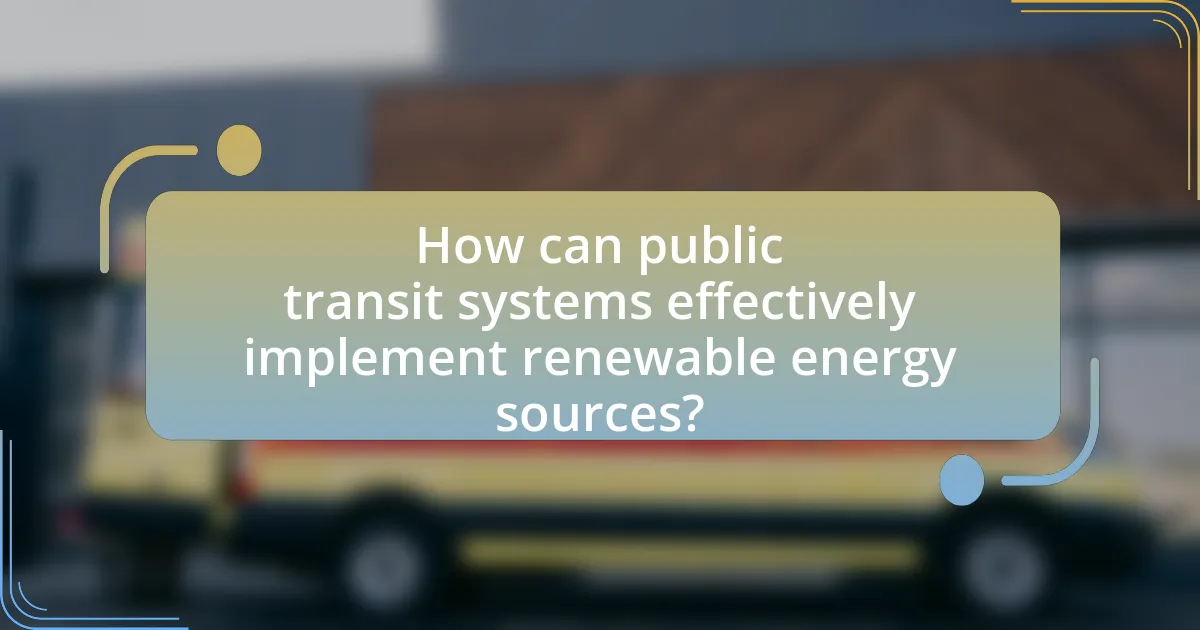
How can public transit systems effectively implement renewable energy sources?
Public transit systems can effectively implement renewable energy sources by transitioning to electric and hydrogen fuel cell vehicles, utilizing solar panels at transit facilities, and integrating energy storage solutions. Electric buses and trains reduce greenhouse gas emissions and operational costs, as evidenced by the California Air Resources Board’s report showing that electric buses can save up to $400,000 over their lifetime compared to diesel buses. Additionally, installing solar panels on bus depots and train stations can generate clean energy to power operations, with the National Renewable Energy Laboratory estimating that solar installations can cover up to 100% of energy needs for these facilities. Finally, incorporating energy storage systems allows transit agencies to manage energy supply and demand effectively, enhancing reliability and efficiency in energy use.
What strategies can be employed for successful integration?
Successful integration of renewable energy sources into public transit systems can be achieved through a combination of strategic planning, stakeholder engagement, and technological innovation. Strategic planning involves assessing the energy needs of the transit system and identifying suitable renewable sources, such as solar or wind energy, that can be harnessed effectively. Stakeholder engagement is crucial, as it ensures that all parties, including government agencies, transit authorities, and the community, are aligned and supportive of the integration efforts. Technological innovation plays a key role, as advancements in energy storage and smart grid technology can enhance the efficiency and reliability of renewable energy use in transit systems. For instance, the implementation of electric buses powered by solar energy has been successfully demonstrated in cities like Los Angeles, where the integration of renewable energy has led to reduced emissions and operational costs.
How can public transit authorities collaborate with energy providers?
Public transit authorities can collaborate with energy providers by establishing partnerships to develop and implement renewable energy solutions for transit systems. This collaboration can include joint investments in solar panels or wind turbines at transit facilities, which can supply clean energy for electric buses and trains. For instance, the Los Angeles Metro has partnered with energy companies to install solar energy systems, significantly reducing operational costs and carbon emissions. Such initiatives not only enhance energy efficiency but also promote sustainability within public transit, aligning with broader environmental goals.
What role does technology play in the integration process?
Technology plays a crucial role in the integration process of renewable energy sources into public transit systems by enabling efficient energy management and optimizing operational performance. Advanced technologies such as smart grid systems facilitate real-time monitoring and control of energy flows, ensuring that renewable energy is effectively utilized. For instance, the implementation of energy storage solutions, like batteries, allows transit systems to store excess energy generated from renewable sources, which can be used during peak demand times. Additionally, data analytics and IoT devices enhance route optimization and energy consumption tracking, leading to reduced operational costs and improved service reliability. Studies have shown that cities employing these technologies can achieve significant reductions in greenhouse gas emissions, thereby validating the effectiveness of technology in this integration process.
What are the best practices for transitioning to renewable energy in public transit?
The best practices for transitioning to renewable energy in public transit include conducting comprehensive feasibility studies, investing in infrastructure upgrades, and implementing pilot programs. Comprehensive feasibility studies assess the potential for renewable energy sources, such as solar or wind, to meet transit energy needs, ensuring that investments are based on accurate data. Infrastructure upgrades, such as installing electric vehicle charging stations and retrofitting existing facilities, are essential for supporting new technologies. Pilot programs allow transit agencies to test renewable energy solutions on a smaller scale, providing valuable insights and data before full-scale implementation. These practices are supported by successful case studies, such as the Los Angeles Metro’s investment in solar energy, which has significantly reduced operational costs and greenhouse gas emissions.
How can pilot programs facilitate the integration of renewable energy?
Pilot programs can facilitate the integration of renewable energy by providing real-world testing environments that demonstrate the feasibility and effectiveness of renewable technologies in public transit systems. These programs allow for the evaluation of various renewable energy sources, such as solar and wind, in operational settings, enabling stakeholders to assess performance metrics, cost savings, and environmental impacts. For instance, a pilot program implemented by the Los Angeles Metro in 2019 tested solar panels on bus shelters, resulting in a 20% reduction in energy costs and showcasing the potential for broader adoption across the transit network. Such evidence supports the scalability of renewable energy solutions in public transit, encouraging investment and policy support for wider implementation.
What lessons can be learned from successful case studies?
Successful case studies in integrating renewable energy sources into public transit systems demonstrate the importance of strategic planning, stakeholder engagement, and technology adaptation. For instance, the implementation of solar panels on buses in Los Angeles has shown that renewable energy can significantly reduce operational costs and greenhouse gas emissions. Additionally, the case of the electric bus fleet in Shenzhen, China, which transitioned 16,000 buses to electric power, illustrates the effectiveness of government policy support and investment in infrastructure. These examples highlight that collaboration among public agencies, private companies, and communities is crucial for achieving sustainable energy integration in transit systems.
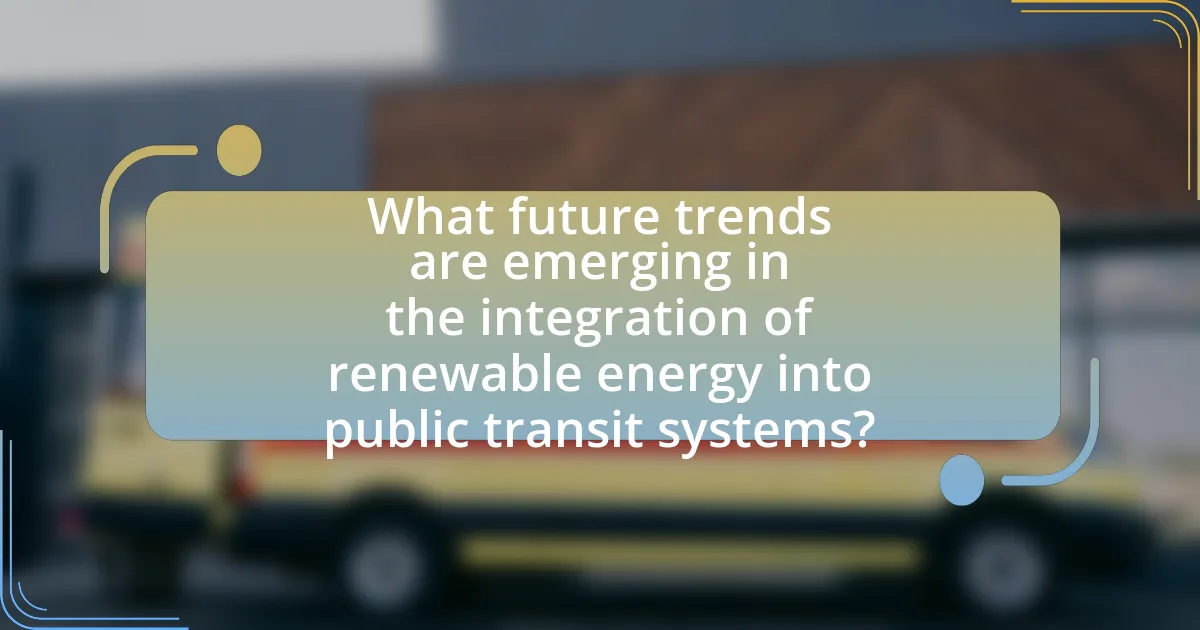
What future trends are emerging in the integration of renewable energy into public transit systems?
Future trends in the integration of renewable energy into public transit systems include the increased adoption of electric buses, the implementation of solar-powered transit infrastructure, and the development of hydrogen fuel cell technology. Electric buses are becoming more prevalent due to advancements in battery technology, which enhance their range and efficiency; for instance, cities like Los Angeles have committed to transitioning their fleets to 100% electric by 2030. Solar-powered transit infrastructure, such as solar canopies at bus stops and charging stations, is being deployed to harness renewable energy directly at transit hubs, exemplified by projects in cities like San Diego. Additionally, hydrogen fuel cell technology is gaining traction as a clean alternative for heavy-duty transit vehicles, with initiatives like the deployment of hydrogen-powered trains in Germany showcasing its viability. These trends reflect a broader commitment to sustainability and reducing carbon emissions in public transportation systems.
How is innovation shaping the future of renewable energy in transit?
Innovation is significantly shaping the future of renewable energy in transit by enabling the development of advanced technologies such as electric and hydrogen fuel cell vehicles. These innovations reduce reliance on fossil fuels, leading to lower greenhouse gas emissions and improved air quality. For instance, electric buses powered by renewable energy sources, like solar and wind, are being deployed in cities worldwide, with examples including Los Angeles’ commitment to a fully electric bus fleet by 2030. Additionally, smart grid technologies facilitate the integration of renewable energy into transit systems, optimizing energy use and enhancing operational efficiency. The adoption of these innovations is supported by research from the International Energy Agency, which highlights that transitioning to electric public transport can reduce urban transport emissions by up to 70% by 2050.
What advancements in technology are expected to enhance integration?
Advancements in technology expected to enhance integration of renewable energy sources into public transit systems include smart grid technology, energy storage solutions, and vehicle-to-grid (V2G) systems. Smart grid technology enables real-time monitoring and management of energy flows, facilitating the efficient use of renewable energy. Energy storage solutions, such as advanced batteries, allow for the storage of excess energy generated from renewable sources, ensuring a stable supply for transit systems. Vehicle-to-grid systems enable electric vehicles to return energy to the grid, optimizing energy use and enhancing integration with renewable sources. These technologies collectively support the transition to sustainable public transit by improving energy efficiency and reliability.
How might policy changes influence the future of renewable energy in public transit?
Policy changes can significantly accelerate the adoption of renewable energy in public transit by providing financial incentives, regulatory frameworks, and infrastructure support. For instance, government policies that offer tax credits or grants for electric buses can lower operational costs and encourage transit agencies to transition from fossil fuels to renewable energy sources. Additionally, regulations mandating emissions reductions can compel public transit systems to invest in cleaner technologies. A study by the International Energy Agency indicates that supportive policies can lead to a 30% increase in the deployment of electric buses by 2030, demonstrating the direct impact of policy on renewable energy integration in public transit.
What practical steps can public transit systems take to begin integrating renewable energy?
Public transit systems can begin integrating renewable energy by implementing solar panels on transit facilities and vehicles. This step allows for the generation of clean energy on-site, reducing reliance on fossil fuels. For instance, cities like San Diego have installed solar panels on bus depots, which has led to significant energy savings and reduced greenhouse gas emissions. Additionally, public transit systems can invest in electric buses powered by renewable energy sources, such as wind or solar, to further decrease their carbon footprint. According to the American Public Transportation Association, transitioning to electric buses can reduce emissions by up to 80% compared to traditional diesel buses. These practical steps not only promote sustainability but also enhance the overall efficiency of public transit operations.
How can stakeholders assess their current energy usage and needs?
Stakeholders can assess their current energy usage and needs by conducting a comprehensive energy audit that evaluates consumption patterns, identifies peak usage times, and analyzes energy sources. This process typically involves collecting data on energy bills, usage metrics from smart meters, and operational schedules to understand how energy is utilized across different transit operations. According to the U.S. Department of Energy, energy audits can reveal opportunities for efficiency improvements, which can lead to a reduction in energy costs by 10-30%. By utilizing this data, stakeholders can make informed decisions about integrating renewable energy sources, ensuring that energy needs align with sustainability goals.
What resources are available for public transit systems to explore renewable energy options?
Public transit systems can access various resources to explore renewable energy options, including government grants, research studies, and industry partnerships. For instance, the Federal Transit Administration (FTA) offers funding through programs like the Low or No Emission Vehicle Program, which supports the purchase of zero-emission and low-emission transit buses. Additionally, organizations such as the American Public Transportation Association (APTA) provide guidelines and best practices for integrating renewable energy into transit operations. Research studies, such as those published by the National Renewable Energy Laboratory (NREL), offer data and analysis on the feasibility and impact of renewable energy technologies in public transit. These resources collectively enable transit systems to make informed decisions about adopting renewable energy solutions.
